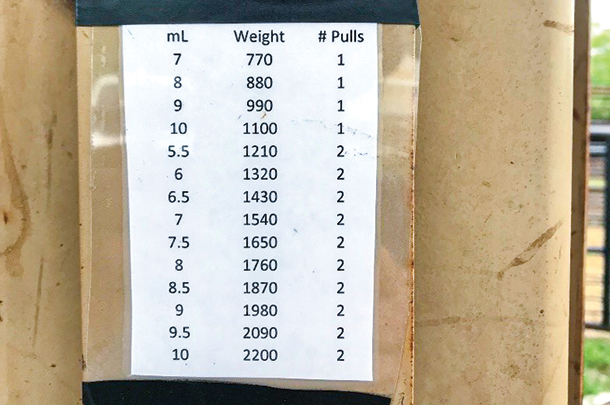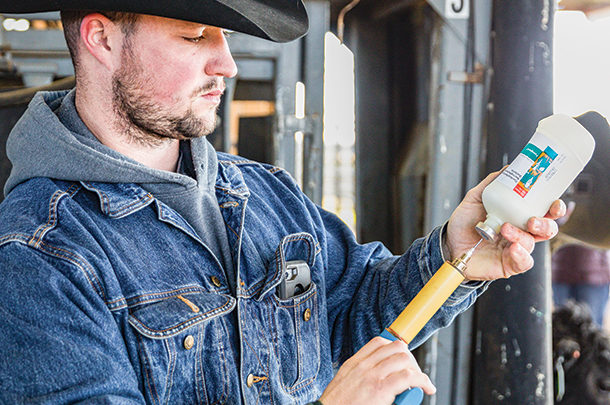There are many facets that can be considered in an extensive health program, but the one key piece is proper vaccination use.
Producers typically put a lot of thought into two things: which vaccines and wormers to use when it comes to processing cattle at different times of the year and what type of antibiotic to use and have on hand if an animal becomes sick and requires treatment.
Vaccines are typically labeled by the dose, such as 2 milliliters per head, while wormers and antibiotics are labeled for a certain milliliter per bodyweight, such as 2.5 milliliters per 33 pounds of bodyweight. Producers will need to decide on how accurately to dose the animals when using products labeled with a per-pound application rate.
The trouble with estimates
Typically, when administering wormers, producers estimate the average weight of animals being processed that day. When administering antibiotics, they estimate the weight of the individual animal. Then they dose all animals that day based off those predefined averages. The problem is: This scenario is multifaceted.
By using an average dose for the herd, a producer is either over- or underdosing most individual animals. Very few are dosed accurately. Underdosing animals can lead to resistance and loss of efficacy for the product being used. Overdosing costs producers money due to administering excessive product and potentially extends the withdrawal times before animals are cleared for slaughter.
Cutting costs by weighing cattle
The ability to weigh animals while they are in the chute makes dosing animals individually more precise. A few years ago, when we were preparing for our spring cattle working here at Noble Research Institute, we decided to prepare a dosing chart that listed different volumes of wormer for specified weight ranges. The dosing chart, which complies with BQA standards for proper injections, listed number of injections with a reduced volume per injection. This allowed us to properly administer the product without injecting more than 10 milliliters per injection site.
We taped the dosing chart to the side of the chute where the wormer was being administered. Our scenario looked something like this: Someone would call out the weight – then the person administering the wormer referred to the dosing chart, dialed the worming applicator to the appropriate setting and administered the product.
Key factors in this method include being able to weigh an animal at processing and having an environment in which the person administering the product can hear the weight called out amid the noise surrounding a processing event and can see well enough to properly adjust the applicator.
On one particular herd we were processing, we would typically have estimated the average weight of the cows at 1,400 pounds. The actual average weight for this herd was 1,488 pounds with a range of 1,070 to 1,745 pounds. Without using the dosing chart, we would have heavily overdosed the lightest cow and severely underdosed the heaviest cow. Using the dosage chart, we saved 70 milliliters of product that day, which accounted for a cost savings of almost $100.
High-tech and low-tech options
There are electronic dosing applicators available on the market designed to receive a scale weight via a Bluetooth or Wi-Fi connection, then automatically adjust the dosage of a wormer or antibiotic for an individual animal. The use of the dosage chart is a low-cost method of decreasing over- and underdosing animals. While it may not be as precise as the auto-applicators, it can be used as a first step in a more intentional animal management system.

Using the dosage chart, we not only effectively wormed the cattle, but we were more efficient in our dosing methods as well. Accurately dosing the animals helped curb potential harmful side effects and provided a significant cost savings when used across all herds.
Gaining consumer confidence
A complete health and immunization program developed with your veterinarian is an important part of successful cattle development. Using proper protocols for administering vaccines, wormers and antibiotics can keep cattle healthy, helping producers feel confident in their product. As producers, we want to assure consumers we are doing everything possible to deliver them a safe and healthy product for consumption. ![]()
PHOTO 1: Proper vaccination use is a key piece of a comprehensive herd health program.
PHOTO 2: The Noble Research Institute dosing chart shown is attached to one of the working facility chutes. Photos courtesy of Noble Research Institute.

-
Devlon Ford
- Agricultural Consultant and Research Associate
- Noble Research Institute
- Email Devlon Ford









